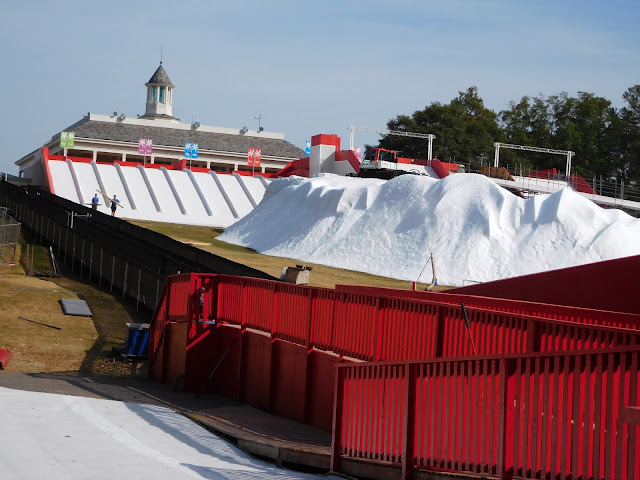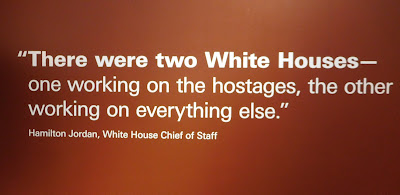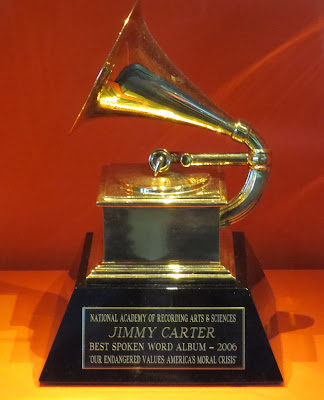“We
must adjust to changing times and still hold to unchanging principles.” Miss Julia Coleman, high school teacher of
President Jimmy Carter
Carol
writes: We seemed
to be traveling in time through a perpetual fall season as we moved south. Our next campground was on the grounds of
gorgeous Stone Mountain Park, a privately run campground and theme park just
outside the beltway around Atlanta. Fall
colors were at their peak at Stone Mountain,
best known for the memorial relief
carving of three Confederate leaders— Stonewall Jackson, Robert E. Lee, and
Jefferson Davis— on the world’s largest granite monolith.
With the exception of the carving, there was
little of interest to us in the theme park that has been developed at the foot
of massive Stone Mountain. In fact, to
my way of thinking, the whole theme park idea seemed jarring and inappropriate. The artificial snow slides built of gaudy red
construction, center stage at the base of the carving, looked especially tacky,
especially in the view from atop Stone Mountain.
 |
The reason for our stay in the Atlanta area was
twofold:
connecting up with old friends…
and visiting the Carter Presidential Center.
We had another very delightful visit with Al’s
classmate Pem and his wife, Lucy, in their lovely home. We were excited this time that Todd, another
classmate from the class of 1969 that Al hadn’t seen in 37 years, could join us
for dinner on the square in downtown Marietta.
In spite of vastly different career paths spanning
several decades, it was obvious the bonds of friendship formed as classmates so
many years ago were deep and strong…
 |
| Al, Pem, and Todd |
We were determined to brave notorious Atlanta traffic and
head into the city to visit the Jimmy Carter Presidential Museum. The museum’s architectural style of
unobtrusive circular buildings nestled into the landscape appeared to reflect
Jimmy Carter’s unpretentious style and simple southern roots.
The museum and library complex were located on a
lovely 30-acre high point on the outskirts of Atlanta on the site of a former
plantation residence that was used as the headquarters of Union General William
Tecumseh Sherman as he commanded the siege of Atlanta. Today, the skyscrapers of Atlanta could be
seen peaking up over the hill.
We found the Carter Museum to be excellent! As always, we were fascinated with the intriguing
life story of a man of such humble beginnings who once held the most powerful
office in the world.
Personal memorabilia from President Carter’s
boyhood were particularly fascinating…
his birth certificate on which it was written that
he will be called
Jimmy
now— but later, of course, I will be “Jim”
I wondered
why that didn’t happen…
his naval officer shoulder boards, Naval Academy
class ring, and submariner insignia.
As always, the oval office replica was
fascinating.
As the museum pointed out, the Carter presidency
was dominated by the Iran hostage crisis, which only came to a resolution the
very moment President Carter left office and Ronald Reagan was sworn in.
It is perhaps Jimmy Carter’s post presidential accomplishments
that are the ones for which he is most universally admired: his work building homes with Habitat for Humanity,
a prolific author of 29 books,
winner of a Grammy for one of his audiobooks,
recipient, along with wife Rosalyn, of the Medal
of Freedom, the nation’s highest civilian honor,
and winner of the Nobel Peace Prize for his work
with the Carter Center, a nonprofit international organization he founded to advance
human rights, prevent disease, and deal with conflict resolution.
Since we had already braved bumper-to-bumper
traffic into Atlanta, we decided to make the most of our day in the city and
head over to CNN Center for a behind-the-scenes studio tour. The multistory atrium of CNN was impressive. We couldn’t help noticing that there was a
very heavy security presence, for obvious reasons.
The tour itself was mildly informative. The most interesting part was the view down
into the news gathering section. Sadly,
there were no pictures allowed…
After the CNN tour we took a short walk
through nearby Centennial Olympic Park, a permanent legacy to the 1996 Olympic
games.
Our friend Lucy graciously asked us to spend
a day with her in Atlanta at the Atlanta History Center. Inspired by her deep love for her home state
of Georgia, Lucy proved to have a wealth of knowledge about Atlanta’s
history. She guided us expertly through
the History Center’s exhibits of
Atlanta-connection treasures and provided additional commentary to further
enhance our understanding...
The history center reminded us that Atlanta is the
home of Chick-fil-A,
Coca Cola,
Hank Aaron,
and golf legend Bobby Jones, one of the greatest ever to play the game and winner of golf’s
Grand Slam—all four major tournaments of his era in a single calendar year.

The tour through the classically styled Swan
House mansion on the grounds of the History Center was entertaining. Our tour guide assumed the identity of Philip Schutze, architect of the mansion which was
built in 1928 for wealthy Atlanta residents Edward and Emily Inman.
 |
| Lucy greets "Mr. Schutze" |
The rooms of Swan House clearly demonstrated the
opulent 1930s Atlanta lifestyle of this rich and famous family…
the dining room,
the unusual green-plastered morning room,
and the library.
We had a delicious lunch with Lucy at the History
Center tearoom, and that put the exclamation point on an all-round fascinating
day in Atlanta with Lucy as our guide!
 |
| Atlanta from the Ashes: The Phoenix |
A week in the Atlanta area proved to be way
too short to see all that a world-class city such as Atlanta has to offer. It struck me with great irony that the President Jimmy
Carter Museum and Library complex… dedicated to a boy born in rural southern
Georgia... is situated on land
where General Sherman once plotted the destruction of Atlanta and the death
knell of the Confederacy. It seemed most
appropriate that the symbol of the phoenix has been adopted by the city of
Atlanta to celebrate its rise from the ashes of the Civil War.
“I
want the American people to understand my character, my weaknesses, the kind of
person I am.” President Jimmy Carter




















































